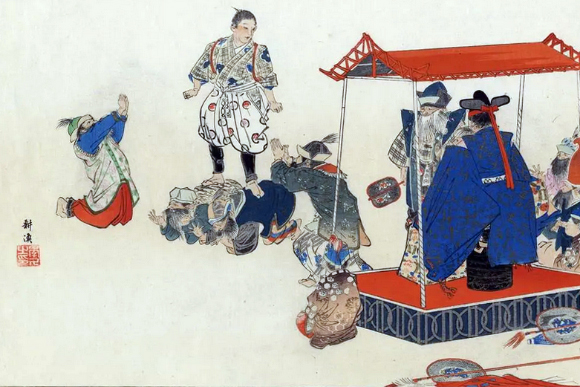| TďZUMď |
| Play titles | T˘zum˘ Wrestling in China |
||||||||||||||||||||||||
| Authors | Furukawa Hisashi (lyrics) Kashiwa Senzaemon (music) Fujima Kanjűr˘ VI (choreography) |
||||||||||||||||||||||||
| History |
In 1957, the Ky˘gen dance-drama "T˘zum˘", which had not been performed for 100 years, was revived by Nomura Manz˘ VI as part of a gala for the ďkurakai (the ďkura Society). Onoe Sh˘roku II was a member of the audience and he particularly enjoyed the performance. He pushed to make a Kabuki adaptation, which was premiered in January 1958 at the Shinbashi Enbuj˘ [more details]. The production was supervised by the ky˘genshi Nomura Manz˘ VI and the leading musicians were the utakata Fujita Senz˘ VII, the hayashigata Sumita Ch˘zabur˘ III and the shamisen-player Kashiwa Senzaemon. So far, "T˘zum˘" was staged only 3 times between 1958 and 2012:
|
||||||||||||||||||||||||
| Key words |
Gidayű Kanjin Kanjo Karako Ky˘gen Matsubamemono Morokoshi Nagauta Shosagoto Sum˘ Sum˘mono T˘jin Tsűji |
||||||||||||||||||||||||
| Summary |
The play itself is set in Morokoshi at the ancient Chinese Tang imperial court and, when the curtain rises, the stage represents the magnificent palace of the Emperor. A certain strong Japanese sum˘tori, who has long been resident at the Chinese court to fulfill the Emperor's interest in sum˘, feels a strong home-sickness, and asks the Emperor through the interpreter [1] (tsűji) for permission to return home to Japan. The Emperor consents readily to the wrestler's request, but insists on seeing the man's wrestling again before he leaves Morokoshi. Accordingly, the courtiers (kanjin) line up to take him on, but the sum˘tori beats all of them easily. The Emperor is a bit displeased at this, so he gets the wrestler very drunk with sake, and then takes him on himself. Then the Emperor makes the wrestler drink, and has a wrestling match with him. But even drunk, and even though the Emperor is protected by his minions, the sum˘tori still wins, and is about to throw the Emperor to the ground when the Empress intervenes. The wrestler wins a valuable fan that the Emperor has unwisely promised to the victor, and is allowed to go home at last. The Emperor and Empress go out of the palace, accompanied by their retinue of courtiers (kanjin), court ladies (kanjo) and Chinese boys (karako). Still drunk, the sum˘tori sees off the procession. This summary would have not been possible without the help of Marion Hudson |
||||||||||||||||||||||||
| Trivia |
This is an unusual matsubamemono due to the number of actors on stage: instead of the usual 3 to 5 performers, there were in January 1958 at the Shinbashi Enbuj˘ the 4 leading actors (the wrestler, the emperor, the empress and the interpreter), 16 kanjin, 4 kanjo and 3 karako. |
||||||||||||||||||||||||
| Notes |
[1] "Except for the sum˘ wrestler and the "translator", they all speak "Chinese" - actually nonsense, and I spend some time speculating as to whether the actors have really learnt the nonsense, or if they make it up as they go along - although this could make picking up cues difficult!" (Marion Hudson, 2012) |
 |
|
"T˘zum˘" (woodblock print for the N˘ theater) |
|
|
| Contact | Main | Top | Updates | Actors | Plays | Playwrights | Programs | Links | FAQ | Glossary | Chronology | Illustrations | Prints | Characters | Derivatives | Theaters | Coming soon | News |